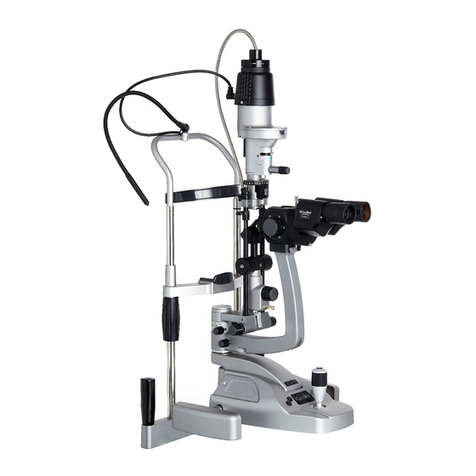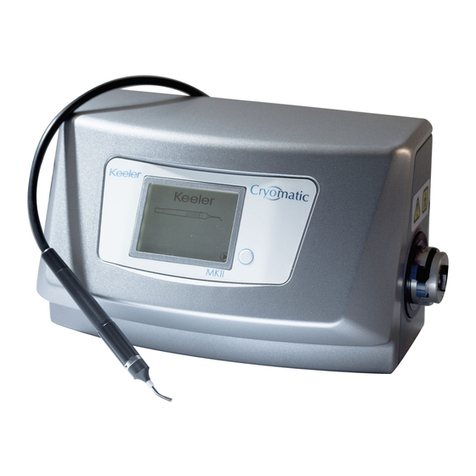
4SLIT LAMP by KEELER www.keeler.co.uk
3 indicationS for uSe 5 brief deScription of the inStrument
4 intended uSe / purpoSe of inStrument
This Keeler Slit Lamp is an AC-powered slit lamp biomicroscope and is
intended for use in eye examination of the anterior eye segment, from
the cornea epithelium to the posterior capsule. It is used to aid in the
diagnosis of diseases or trauma which affects the structural properties of
the anterior eye segment.
This device is intended to be used only by suitably trained and authorised
healthcare professionals.
This Keeler Slit Lamp can either be mounted onto a custom table
top supplied by Keeler or can be mounted on a third parties table top
(refraction unit) by suitably trained technicians.
The Keeler Slit Lamp consists of 5 assemblies; Illumination Tower;
Observation System; XYZ Translation Base; Chinrest Assembly and a Table
Top with Power Supply and Accessory Drawer.
The light intensity is controlled by a variable rheostat located on the XYZ
Translation Base. There are a number of selectable filters allowing the
user to control the characteristics of the examination light.
The Keeler Slit Lamp is designed and built in conformity with EC
Directive 93/42/EEC and the ISO 9000 and ISO 13485 series of quality
standards.
The ‘CE’ (European Community) mark attests that the Keeler Slit
Lamp complies with the provisions of the EC Directive 93/42/EEC.
Classification: CE Regulation 93/42 EEC: Class I
FDA: Class II
IEC/EN Standard 60601-1: H-series - Safety Class II
Application part: Type B
Operation mode: continuous operation
Production processes, testing, start-up, maintenance, and repairs
are conducted in strict conformity with the applicable laws and
international reference standards.
The Slit Lamp is an instrument consisting of a light source that can
be focused to shine a thin sheet (slit) of light into the eye. It is used in
conjunction with a biomicroscope. The lamp facilitates an examination
of the anterior segment, or frontal structures and posterior segment,
of the human eye, which includes the eyelid, sclera, conjunctiva, iris,
natural crystalline lens, and cornea. The binocular Slit Lamp examination
provides stereoscopic magnified view of the eye structures in detail,
enabling anatomical diagnoses to be made for a variety of eye conditions.
Caution: Federal Law restricts this device to sale by or on the order of a
physician or practitioner.





























